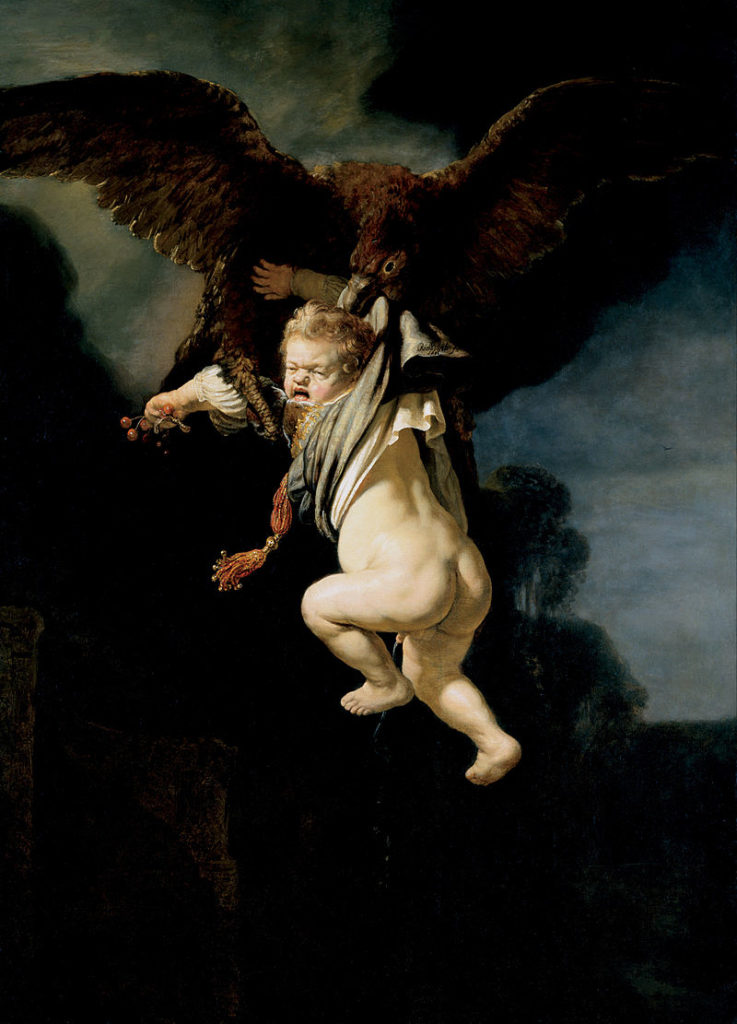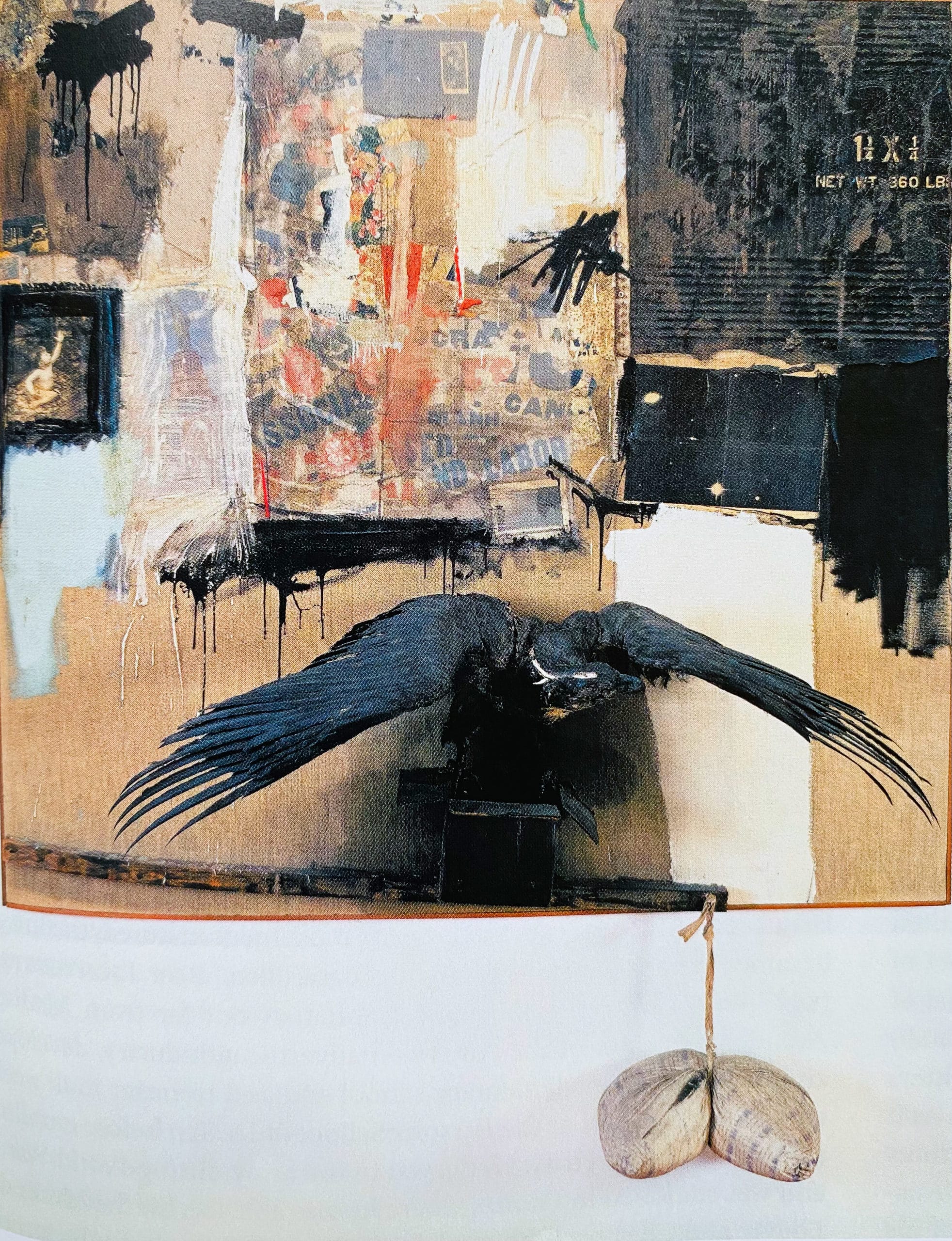What’s the meaning of Robert Rauschenberg’s Canyon painting?
- A bird, a pillow, a god and a boy’s bottom
- An excuse for trauma built into Greek myth
- Canyon’s three dimensions create depth
Click here for the podcast version of this post
Robert Rauschenberg’s artwork Canyon is more than a painting. That’s not only because of its complex physicality. Rauschenberg piled a lot on his canvas. It was: oil, pencil, an eagle, paper, a pillow, fabric, metal, cardboard, a photograph, wood, a paint tube, and a mirror. He also included printed reproductions and hung the pillow from a string. This assemblage tells a mythical story. Rauschenberg seems to skew these ingredients rather than aligning them. He tilted the items and overlaid them to evoke a sense of chaos. It shows viewers how this myth might make us feel. His constructed chaos works like a thunder rumble before the storm hits.
Canyon‘s story reads like a tragedy. So, this fits. It’s the tale of Ganymede – the beautiful boy of myth. In The Iliad we learn that:
[Ganymede] was the loveliest born of the race of mortals, and therefore the gods caught him away to themselves, to be Zeus’ wine-pourer, for the sake of his beauty, so he might be among the immortals.
— Homer, Iliad, Book XX, lines 233–235
The boy was so gorgeous that the gods made a special exception for him. They stole him away from the mortal world in secret. If this sounds like a story concocted by a bunch of dirty old men, you have good ears. It’s exactly that. Ancient Greeks were notorious for young boy obsessions. The story of this irresistible example served their purposes. It set up a model for them as an excuse. They could romanticize and attempt to justify abusive proclivities. This twisted storytelling dynamic sets the stage for Canyon.
We get the word pedophile from the Greek social custom paiderastía. This was a “romance” between an adolescent male and an adult. It now signifies various terms (such as catamite) that serve to insult or emasculate men. In fact, the word catamite literally translates to Ganymede and often means a recipient of anal intercourse today. So, this myth remains fraught with complex meaning. An ancient excuse for pedophilia indicates abuse in our current world. There’s nothing romantic about it. Thus we find ourselves in the depths of Rauschenberg’s Canyon. Our eyes wander the scene, like a lost hiker in the craggy bowels of a gorge. That’s thanks to the painter’s complex composition.
Art History Reflected in Canyon
Rauschenberg refers to Rembrandt’s painting, The Abduction of Ganymede in Canyon (below). That’s the source for Rauschenberg’s eagle. The Rembrandt painting portrays the scene in the Ganymede myth when Zeus swoops in as an eagle. He carries the boy to the heavens. That’s where the gods will have their way with the child. It’s also why the painting often goes by another title – The Rape of Ganymede. After all, there’s more to the story than abduction. The Greeks didn’t concoct this story as justification for kidnapping young boys. They took it much farther.
The painter also pushes Canyon to the edge and beyond. If you need more proof than the actual eagle strung at its center, I offer you a pillow. Below the painting edge, Rauschenberg hung a plump pillow. It’s fabric glistens like flesh against the white backdrop. The artist explained that the pillow works as a visual pun representing the young boy’s butttocks. At first glance, this masterpiece may seem like a random collage. But once viewers know the references to Ganymede and Rembrandt, it sings a specific and tragic song.

Canyon – FAQs
What makes Canyon by Robert Rauschenberg an important painting?
While Canyon may be typical of Rauschenberg’s assemblage style of painting, it also stands out. Many of his works include objects like those we find on Canyon‘s canvas. Here the painter includes an eagle, a pillow, and many more items.
But it’s the message behind these objects that makes this artwork unique in art history canon. Canyon not only speaks to the myth of Ganymede, it subverts the story as well. Rauschenberg spotlights the assaulted young boy’s buttocks. He’s crude on purpose. So, the painting speaks to us about the exploitation of a young boy’s beauty and body.
What kind of painting is Canyon by Robert Rauschenberg?
Rauschenberg loved to combine paint, canvas, objects, and media images in his works. He called them “combines”. They were complex assemblages that told stories. Rauschenberg gives viewers three dimensions which adds depth and resonance to the works.
Canyon evokes the story behind a Greek myth using pigment, canvas, and stunning objects. It’s a visual stunner, with an eagle and pillow to punctuate the painter’s point. He created controversy, awareness, and awe all at once with this constructed collage-turned- masterpiece.
How is the Greek myth of Ganymede relevant today?
The Latin form of the name Ganymede translates to Catamitus. This is where we get the English word catamite. It’s a familiar word for those steeped in literary studies. From Plato’s dialogues to Ulysses and C.S. Lewis to Cormac McCarthy’s novel The Road; this term stays in the vernacular.
That may be due to its inherent intrigue. Even though it appears in literature, catamite remains a nasty term. In fact, the character Stephen Dedalus in Ulysses uses it in wonder about if William Shakespeare was a pedophile. When an author wishes to call out a child molester, they need look no further – catamite fits just fine.
ENJOYED THIS Canyon ANALYSIS?
Check out these other essays on American Artists
Gibson, Eric (2 December 2012). “The Illegal Eagle and a Baldly Grasping IRS”. The Wall Street Journal.
See Canyon at the MOMA website
Bois, Yve-Alain. “Eye to the Ground.” Artforum International. Artforum Inc. March, 2006.
MoMA Highlights: 375 Works from The Museum of Modern Art, New York (New York: The Museum of Modern Art, 2019)
The Rape of Ganymede in the Rembrandt database
Woodford, Susan (1993). The Trojan War in Ancient Art. Ithaca, NY: Cornell University Press
Craig Williams, Roman Homosexuality (Oxford University Press, 1999, 2010)
Read the relevant Plato Dialogue – Gorgias
Cotter, Holland (19 December 2013). “A Legendary Dealer’s Eagle Eye”. The New York Times.
McCarthy, Cormac. The Road. New York: Vintage Books, 2006. Print.
Ulysses”, The Oxford Companion to English Literature (1995), edited Margaret Drabble. Oxford UP, 1996.
